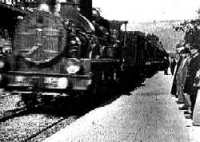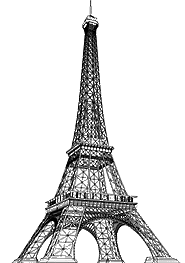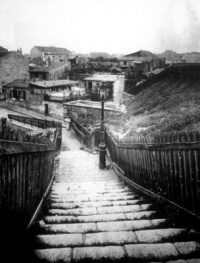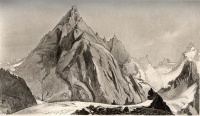France
From The Art and Popular Culture Encyclopedia

|
Related e |
|
Featured: |
France is a European country bordered by Belgium, Luxembourg, Germany, Switzerland, Italy, Monaco, Andorra, and Spain.
France is the most visited country in the world, receiving over 75 million foreign tourists (including business visitors) annually.
Contents |
Culture
Literature
The earliest French literature dates from the Middle Ages when the area that is modern France did not have a single, uniform language. There were several languages and dialects and each writer used his own spelling and grammar. The author of many French mediaeval texts is unknown, for example Tristan and Iseult and Lancelot and the Holy Grail. Much mediaeval French poetry and literature was inspired by the legends of the Matter of France, such as the The Song of Roland and the various Chansons de geste. The “Roman de Renart”, written in 1175 by Perrout de Saint Cloude tells the story of the mediaeval character Reynard ('the Fox') and is another example of early French writing. The names of some authors from this period are known, for example Chrétien de Troyes and Duke William IX of Aquitaine, who wrote in Occitan.
An important 16th century writer was François Rabelais who influenced modern French vocabulary and metaphor. During the 17th century Pierre Corneille, Jean Racine and Molière's plays, Blaise Pascal and René Descartes's moral and philosophical books deeply influenced the aristocracy leaving an important heritage for the authors of the following decades. Jean de La Fontaine was an important poet from this century. French literature and poetry flourished in the 18th and 19th centuries. The 18th century saw the works of writers, essayists and moralists such as Voltaire, Denis Diderot and Jean-Jacques Rousseau.
Charles Perrault was a prolific writer of children's stories such as: “Puss in Boots”, “Cinderella”, “Sleeping Beauty” and “Bluebeard”.
At the turn of the 19th century symbolist poetry was an important movement in French literature, with poets such as Charles Baudelaire, Paul Verlaine and Stéphane Mallarmé. The 19th century saw the writing of many French novels of world renown with Victor Hugo (Les Misérables), Alexandre Dumas (The Three Musketeers and The Count of Monte-Cristo), and Jules Verne (Twenty Thousand Leagues Under the Sea) among the most well-known in France and beyond. Other 19th century fiction writers include Emile Zola, Guy de Maupassant, Théophile Gautier and Stendhal.
The Prix Goncourt is a French literary prize first awarded in 1903. Important writers of the 20th century include Marcel Proust, Louis-Ferdinand Céline, Albert Camus, and Jean-Paul Sartre. Antoine de Saint Exupéry wrote Little Prince which has remained popular for decades with children and adults around the world.
Art
The origins of French art were very much influenced by Flemish art and by Italian art at the time of the Renaissance. Jean Fouquet, the most famous medieval French painter, is said to have been the first to travel to Italy and experience the Early Renaissance at first hand. The Renaissance painting School of Fontainebleau was directly inspired by Italian painters such as Primaticcio and Rosso Fiorentino, who both worked in France. Two of the most famous French artists of the time of Baroque era, Nicolas Poussin and Claude Lorrain, lived in Italy.
The 17th century was the period when French painting became prominent and individualized itself through classicism. Louis XIV's prime minister Jean-Baptiste Colbert founded in 1648 the Royal Academy of Painting and Sculpture to protect these artists, and in 1666 he created the still-active French Academy in Rome to have direct relations with Italian artists.
French artists developed the rococo style in the 18th century, as a more intimate imitation of old baroque style, the works of the court-endorsed artists Antoine Watteau, François Boucher and Jean-Honoré Fragonard being the most representative in the country. The French Revolution brought great changes, as Napoleon favoured artists of neoclassic style such as Jacques-Louis David and the highly influential Académie des Beaux-Arts defined the style known as Academism. At this time France had become a centre of artistic creation, the first half of the 19th century being dominated by two successive movements, at first Romanticism with Théodore Géricault and Eugène Delacroix, and Realism with Camille Corot, Gustave Courbet and Jean-François Millet, a style that eventually evolved into Naturalism.
In the second part of the 19th century, France's influence over painting became even more important, with the development of new styles of painting such as Impressionism and Symbolism. The most famous impressionist painters of the period were Camille Pissarro, Édouard Manet, Edgar Degas, Claude Monet and Auguste Renoir. The second generation of impressionist-style painters, Paul Cézanne, Paul Gauguin, Toulouse-Lautrec and Georges Seurat, were also at the avant-garde of artistic evolutions, as well as the fauvist artists Henri Matisse, André Derain and Maurice de Vlaminck.
At the beginning of 20th century, Cubism was developed by Georges Braque and the Spanish painter Pablo Picasso, living in Paris. Other foreign artists also settled and worked in or near Paris, such as Vincent van Gogh, Marc Chagall, Amedeo Modigliani and Wassily Kandinsky.
Many museums in France are entirely or partly devoted to sculptures and painting works. A huge collection of old masterpieces created before or during the 18th century are displayed in the state-owned Musée du Louvre, such as Mona Lisa, also known as La Joconde. While the Louvre Palace has been for a long time a museum, the Musée d'Orsay was inaugurated in 1986 in the old railway station Gare d'Orsay, in a major reorganization of national art collections, to gather French paintings from the second part of the 19th century (mainly Impressionism and Fauvism movements).
Modern works are presented in the Musée National d'Art Moderne, which moved in 1976 to the Centre Georges Pompidou. These three state-owned museums welcome close to 17 million people a year. Other national museums hosting paintings include the Grand Palais (1.3 million visitors in 2008), but there are also many museums owned by cities, the most visited being the Musée d'Art Moderne de la Ville de Paris (0.8 million entries in 2008), which hosts contemporary works.
Outside Paris, all the large cities have a Museum of Fine Arts with a section dedicated to European and French painting. Some of the finest collections are in Lyon, Lille, Rouen, Dijon, Rennes and Grenoble.
Architecture
There is, technically speaking, no architecture named French Architecture, although that has not always been true. Gothic Architecture's old name was French Architecture (or Opus Francigenum). The term “Gothic” appeared later as a stylistic insult and was widely adopted. Northern France is the home of some of the most important Gothic cathedrals and basilicas, the first of these being the Saint Denis Basilica (used as the royal necropolis); other important French Gothic cathedrals are Notre-Dame de Chartres and Notre-Dame d'Amiens. The kings were crowned in another important Gothic church: Notre-Dame de Reims. Aside from churches, Gothic Architecture had been used for many religious palaces, the most important one being the Palais des Papes in Avignon.
During the Middle Ages, fortified castles were built by feudal nobles to mark their powers against their rivals. When King Philip II took Rouen from King John, for example, he demolished the ducal castle to build a bigger one. Fortified cities were also common, unfortunately most French castles did not survive the passage of time. This is why Richard the Lionheart's Château-Gaillard was demolished, as well as the Château de Lusignan. Some important French castles that survived are Chinon, Château d'Angers, the massive Château de Vincennes and the so called Cathar castles.
Before the appearance of this architecture France had been using Romanesque architecture like most of Western Europe (with the exception of the Iberian Peninsula, which used Mooresque architecture). Some of the greatest examples of Romanesque churches in France are the Saint Sernin Basilica in Toulouse and the remains of the Cluniac Abbey (largely destroyed during the Revolution and the Napoleonic Wars).
The end of the Hundred Years' War marked an important stage in the evolution of French architecture. It was the time of the French Renaissance and several artists from Italy and Spain were invited to the French court; many residential palaces, Italian-inspired, were built, mainly in the Loire Valley. Such residential castles were the Château de Chambord, the Château de Chenonceau, or the Château d'Amboise. Following the renaissance and the end of the Middle Ages, Baroque Architecture replaced the gothic one. However, in France, baroque architecture found a greater success in the secular domain than in the religious one. In the secular domain the Palace of Versailles has many baroque features. Jules Hardouin Mansart can be said to be the most influential French architect of the baroque style, with his very famous baroque dome of Les Invalides. Some of the most impressive provincial baroque architecture is found in places that were not yet French such as the Place Stanislas in Nancy. On the military architectural side Vauban designed some of the most efficient fortresses of Europe and became a very influential military architect.
After the Revolution the Republicans favoured Neoclassicism although neoclassicism was introduced in France prior to the revolution with such building as the Parisian Pantheon or the Capitole de Toulouse. Built during the French Empire the Arc de Triomphe and Sainte Marie-Madeleine represent this trend the best.
Under Napoleon III a new wave of urbanism and architecture was given birth. If some very extravagant buildings such as the neo-baroque Palais Garnier were built, the urban planning of the time was very organised and rigorous. For example Baron Haussmann rebuilt Paris. The architecture associated to this era is named Second Empire in the English speaking world, the term being taken from the Second French Empire. These times also saw a strong Gothic-Revival trend across Europe, in France the associated architect was Eugène Viollet-le-Duc. In the late 19th century Gustave Eiffel designed many bridges (like the Garabit viaduct) and remains one of the most influential bridge designer of his time, although he is best remembered for the Eiffel Tower.
In the 20th century the Swiss Architect Le Corbusier designed several buildings in France. More recently French architects have combined both modern and old architectural styles. The Louvre Pyramid is a good example of modern architecture added to an older building. Certainly the most difficult buildings to integrate within French cities are skyscrapers, as they are visible from afar. France's largest financial district is La Defense, where a significant number of skyscrapers are located. Other massive buildings that are a challenge to integrate into their environment are large bridges; a good example of the way this has been done is the Millau Viaduct. Some famous modern French architects include Jean Nouvel or Paul Andreu.
See also
- French art
- French culture
- History of France
- French censorship
- Venus in France
- French literature
- French philosophy
- Francophilia
- Stereotypes of French people






